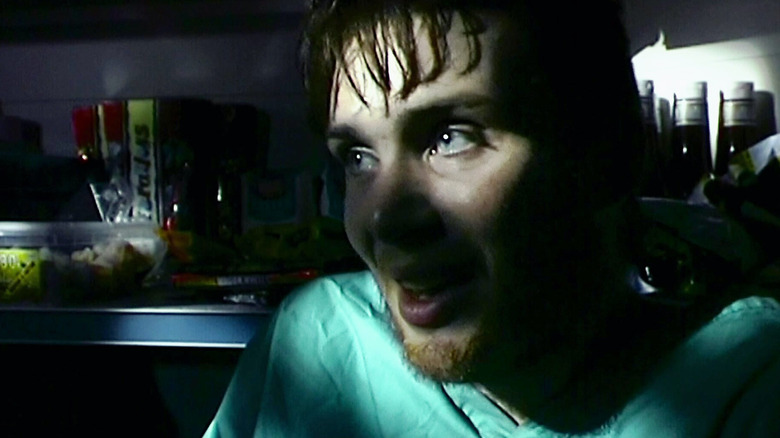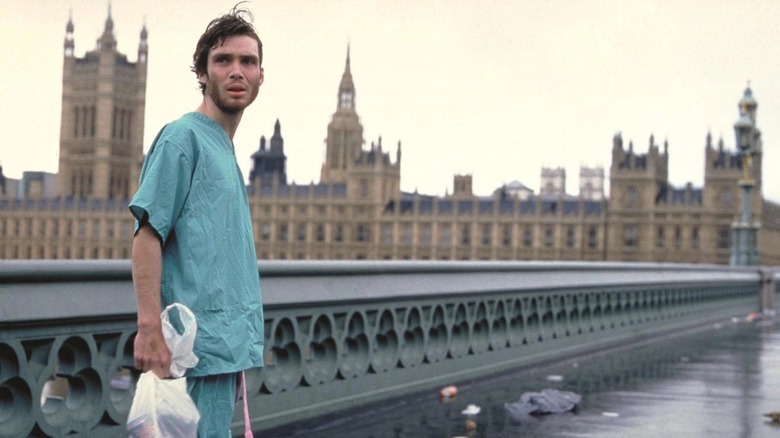One Of The Most Anticipated Horror Movies Of All Time Was Shot With An iPhone
The future is now, old man. When director Danny Boyle's horror classic "28 Days Later" first released in the United States back in June of 2003, the now-ubiquitous piece of tech known as the iPhone still remained almost exactly four years away from debuting. In the decades since, artists have found some unique ways to put these phones through their paces — everything from music videos to feature-length movies have now been touted as being shot entirely on iPhones. The appeal is rather self-explanatory, with the idea being that storytellers of this tech-savvy generation need little more than ambition, creativity, and an iPhone to become genuine filmmakers in their own right. Forget all those stuffy (and exclusive) film schools or nepo-baby connections, because now anyone can shoot a movie with the most common smartphone of all.
That's the feel-good story associated with the news that the long-awaited zombie sequel, "28 Years Later," will stay true to the franchise's original DIY-inspired roots. WIRED reports that Boyle's follow-up movie was filmed this past summer on specially modified iPhone 15s. In and of itself, that might not seem very remarkable, especially in a world where Steven Soderbergh already pulled this feat off twice; first with the 2018 psychological thriller "Unsane" and then the underrated sports drama "High Flying Bird" a year later. What sets this development apart, however, is the fact that "28 Years Later" carries a hefty budget of $75 million and thus marks the most expensive movie ever shot on a smartphone.
28 Years Later is keeping the franchise's innovative streak going
It's easy to forget in a post-"The Walking Dead" world, but the zombie genre didn't always have a steady pulse. One of the first titles to provide a shock to the system was Danny Boyle's "28 Days Later," written by Alex Garland and starring Cillian Murphy, who is slated to return for the sequel alongside the trio of new additions Aaron Taylor-Johnson, Jodie Comer, and Ralph Fiennes. The film didn't just change the game by introducing the concept of fast, runner-like zombies, but it also hearkened back to the days of George Romero himself with its grainy cinematography and its almost indie-like production — one that, paradoxically, remained on the cutting edge by becoming one of the first films to ever shoot with a Canon XL-1 digital camera (as also cited by WIRED). Now, that tradition for pushing the envelope is being kept alive with "28 Years Later."
Intriguingly, WIRED reports that the cast and crew went to great lengths to keep this iPhone detail under wraps, even signing NDAs to prevent anyone from revealing this information. That's never stopped internet sleuths before (read: paparazzi), of course, and the outlet confirmed that the sequel was shot specifically with a number of iPhone 15 Pro Max smartphones. Although exact story details have thus far eluded the general public, it's likely that Boyle, Garland, and returning cinematographer Anthony Dod Mantle are hoping to match the original movie's grimy and low-budget aesthetic. As an added bonus, Boyle's previous composer on "Yesterday," Daniel Pemberton, took to Twitter (now known as X) to praise the news and offer up his own personal commentary:
"For part of [the] score for YESTERDAY with Danny Boyle (the scene as Jack drives to meet an infamous fisherman) I recorded the solo music cue straight to voice notes on my iPhone and that's exactly what's in the film..
[Danny Boyle] always has an excellent punk rock attitude to film making."
For part of score for YESTERDAY with Danny Boyle (the scene as Jack drives to meet an infamous fisherman) I recorded the solo music cue straight to voice notes on my iPhone and that's exactly what's in the film..
DB always has an excellent punk rock attitude to film making 👇 https://t.co/3qzvpzNiau
— Daniel Pemberton (@DANIELPEMBERTON) September 19, 2024
The gimmick of shooting with an iPhone can oftentimes come across as exactly that — a gimmick — but there's plenty of reason to hope that this visual choice was made purely out of narrative-based reasons. "28 Years Later" is the first of a planned trilogy and is set to open in theaters on June 20, 2025, with Nia DaCosta rumored to direct the next sequel. Stay tuned to /Film for more updates!

